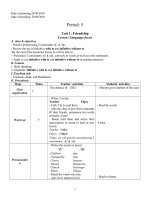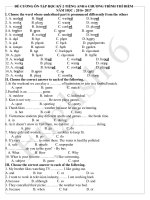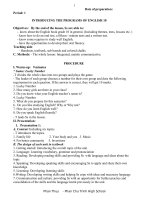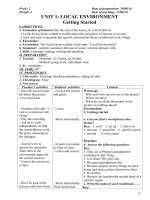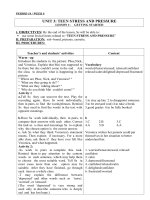giáo án tiết anh 7 chương trình thí điểm unit 5 và 7
Bạn đang xem bản rút gọn của tài liệu. Xem và tải ngay bản đầy đủ của tài liệu tại đây (980.33 KB, 22 trang )
1
Giáo án Tiếng Anh 7
Week: …
Period: …
Date of planning: ……/……/……
Date of teaching: ……/……/……
UNIT 5: VIETNAMESE FOOD
AND DRINK
Lesson 1: Getting Started – Dinner
alone
I. Objectives:
By the end of this lesson, students can
know the key language and structures to be
learnt in this unit.
II. Language Focus:
1. Vocabulary: the lexical items related to
“Vietnamese food and drink”.
2. Structures:
Nouns (countable/
uncountable)
How much/ How many?
a/ an, some, any…
III. Method: Communicative approach
IV. Teaching ads: Course book, CD player,
picture.
V. Procedures:
Teacher’s Activities
- Show the picture and ask Ss
some questions.
- Play the recording.
Ss’ Activities
- Answer
- Ask Ss not to look at the book
and try to remember which food
and drinks are mentioned in the
conversation. Then let them open
their book and check their
answer.
- Pair-work
- Individual work
- Have ss quickly match each
word/ phrase with its picture.
- Play the recording for Ss to
check their answers.
- Pair –work
- First ask Ss to think about their
favorite food and drink, and what
questions they can ask about
their partners’ favorite food and
drink.
- Model this activity with a more
able student. Then ask Ss to work
in pairs.
- Individual work
- Ask Ss to work independently.
Then allow them to share their
answer before discussing as a
class.
- Play the recording and ask Ss to
- Individual worklisten and repeat the adjectives.
- Ask Ss to add more adjectives
and allow them to write the
adjectives on the board.
- Demonstrate the game to the
class first. Describe one or two
favourite foods or drinks and ask
- Group-work
2
Giáo án Tiếng Anh 7
some more able Ss to guess their
name. then when Ss know exactly
what to do, ask them to work in
groups.
Week:
…
Perio
d: …
Date
of
planni
ng:
……/
……/
……
Date
of
teachi
ng:
……/
……/
……
UNIT 5: VIETNAMESE FOOD
AND DRINK
Lesson 2: A Closer Look 1
I. Objectives:
By the end of this lesson, students can
pronounce correctly the sounds /ɒ/ and /ɔ:/ in
isolation and in context; use vocabulary
related to “Vietnamese food and drink”.
II. Language Focus:
1. Vocabulary: the lexical items related to
“Vietnamese food and drink”.
2. Structures:
Nouns (countable/
uncountable)
How much/ How many?
a/ an, some, any…
III. Method: Communicative approach
IV. Teaching ads: Course book, CD player,
flash cards.
V. Procedures:
Teacher’s Activities
Ss’ Activities
- Have Ss complete the
instructions with the verbs in the
box.
- Ask Ss to make some examples
with the verbs they have learnt.
- Individual work
3
Giáo án Tiếng Anh 7
- Ask ss to do the exercise
individually and then check with
the whole class. When checking,
ask Ss to refer to 1 to make the
meanings of the verbs clearer to
them.
- Check Ss’ understanding of the
meanings on the nouns given.
- Explain the meanings by using
pictures, example.
- Have Ss put nouns in the correct
columns.
- Remind Ss that some nouns may
fit in both columns.
- Individual work
.....................................................................................
.....................................................................................
.....................................................................................
.....................................................................................
.....................................................................................
- Individual work
- Listen and
repeat.
- Model the sounds /ɒ/ and /ɔ:/
first and let Ss see how the
sounds are formed.
- Ask Ss to practice the /ɒ/ and
/ɔ:/ sounds together. Play the
recording and ask Ss to listen and
repeat.
- Ask Ss to listen again and put
the words in the correct column.
- Ask Ss to listen while T plays the
recording. Play the recording
again and ask Ss to circle the
words they hear.
- Ask Ss to check their answers.
- Individual work
- Group-work
4
Giáo án Tiếng Anh 7
Week: …
Period: …
Date of planning:
……/……/……
Date of teaching:
……/……/……
UNIT 5: VIETNAMESE FOOD
AND DRINK
Lesson 3: A Closer Look 2
I. Objectives:
By the end of this lesson, students can
distinguish countable nouns and uncountable
nouns; use a/ an, some and any to talk about
quantity; use How much and How many to
ask about quantity.
II. Language Focus:
1. Vocabulary: the lexical items related to
“Vietnamese food and drink”.
2. Structures:
Nouns (countable/
uncountable)
How much/ How many?
a/ an, some, any…
III. Method: Communicative approach
IV. Teaching ads: Course book, CD player,
pictures.
V. Procedures:
Teacher’s Activities
Ss’ Activities
- Ask Ss to study the Grammar
box. Draw Ss’ attention to the
difference between countable
nouns and uncountable nouns
and the use of measurement
phrase, by analyzing the
examples in the Grammar box.
Then ask Ss to give some more
examples. Remind Ss that they
should use a good dictionary to
check if a noun is countable or
uncountable.
- T Whole class
- Ask ss to do this exercise
individually. Remind them to
- Individual work
refer to the Grammar box and
use a dictionary if necessary.
- Have ss compare their answers
in pairs before checking with
the whole class.
- Draw Ss’ attention to the use
of a, an, some, any by analyzing
the instruction and example in
the Grammar box.
- Ask Ss to play the game in
groups. Demonstrate the game
to the class.
- Tell ss what they are supposed
to do. Then ask them to work
individually and share the
answers with their partner
before checking with the whole
class.
- Ask Ss to study the Grammar
box. Help them to distinguish
the use of How many and How
much by analyzing the
instruction and examples in the
Grammar Box.
- Ask Ss to do the task
individually.
- T whole class
- Group – work
- Individual work
- T whole class
- - Individual
work
- Ask Ss to work in pairs, ask and - Pair - work
answer the questions with How
many and How much.
- Call on some Ss and give
comment.
5
Giáo án Tiếng Anh 7
Week
:…
Peri
od:
…
Date
of
plan
ning
:
……/
……/
……
Date
of
teac
hing
:
……/
……/
……
UNIT 5: VIETNAMESE FOOD
AND DRINK
Lesson 4: Communication
I. Objectives:
By the end of this lesson, students can talk
about their favourite food and drink.
II. Language Focus:
1. Vocabulary: the lexical items related to
“Vietnamese food and drink”.
2. Structures:
Nouns (countable/
uncountable)
How much? / How
many?
a/ an, some, any…
III. Method: Communicative approach
IV. Teaching ads: Course book, CD player.
V. Procedures:
Teacher’s Activities
- Help Ss to understand the
meanings of the words in Extra
Vocabulary by using pictures,
example, or even translations.
- Ask Ss to add some more words
naming or describe food and
drink.
Ss’ Activities
- T Whole class
6
Giáo án Tiếng Anh 7
- Ask Ss to look at the picture of
the chef and predict which food
or dishes he might like.
- Play the recording and let Ss
check their predictions. Play the
recording again and ask Ss to tick
the food the chef mentions from
the Extra vocabulary box.
- Have Ss read the questions in
the table carefully and ask them
to note their answers.
- Ask Ss to share their answers in
pairs to find out what they have
in common with their partners.
the whole class.
- T-Whole class - Invite some comments from
other Ss.
- Correct the common errors.
- Individual work.....................................................................................
.....................................................................................
.....................................................................................
- Pair-work
.....................................................................................
.....................................................................................
.....................................................................................
- T whole class
- Ask Ss to move around and ask
different classmates every
question in the table.
- Remind Ss to write the names of
the people they interview and
note the answers in the table.
- Pair-work
- Have Ss practice the results of
their interview in pairs.
- Call on some Ss to report the
results of their interviews before
- Whole class
7
Giáo án Tiếng Anh 7
Week: …
Period: …
Date of planning:
……/……/……
Date of teaching:
……/……/……
UNIT 5: VIETNAMESE FOOD
AND DRINK
Lesson 5: Skill 1
- Ask Ss to read the text again and
answer the questions.
- Ask Ss to note where they found
th information that help them to - Pair-work
answer the questions.
- Have ss compare their answers
before discussing before the
whole class.
I. Objectives:
By the end of this lesson, students can use
read for specific information about Pho, a
popular food in Viet Nam.
II. Language Focus:
1. Vocabulary: the lexical items related to
“Vietnamese food and drink”.
2. Structures:
Nouns (countable/
uncountable)
How much? / How
many?
a/ an, some, any…
III. Method: Communicative approach
IV. Teaching ads: Course book, CD player.
V. Procedures:
Teacher’s Activities
- Ask Ss to look at the picture of a
bowl of pho. Ask them some
questions.
- Ask Ss to scan the passage to
find where the words: stewing,
bones, broth, boneless and slices
are in the passage.
- Pair-work
- Remind Ss of form and use of a/
an, some, any and phrases of
quantity used with uncountable
nouns. Ask Ss to work in pairs,
asking and answering the
questions about the ingredients
- Individual work
for an omelette.
- Ask ss to work individually, using
Ss’ Activities the phrases in the box to
complete the instructions on how
to cook an omelette.
- Have ss share their answers
- Answer
with their partner.
- Give Ss time to think about
some food and drink and how to
make them. Ask them to take
notes about the steps to make
their food and drink.
- Ask Ss to work in pairs to
practice.
- Individual work
- Individual work
- Pair -work
8
Giáo án Tiếng Anh 7
9
Giáo án Tiếng Anh 7
Week: …
Period: …
Date of planning:
……/……/……
Date of teaching:
……/……/……
UNIT 5: VIETNAMESE FOOD
AND DRINK
Lesson 6: Skill 2
I. Objectives:
By the end of this lesson, students can
listen to get the information about different
traditional food and write about some popular
foods or drinks.
II. Language Focus:
1. Vocabulary: the lexical items related to
“Vietnamese food and drink”.
2. Structures:
Nouns (countable/
uncountable)
How much? / How
many?
a/ an, some, any…
III. Method: Communicative approach
IV. Teaching ads: Course book, CD player
V. Procedures:
Teacher’s Activities
- Individual work
- Pair-work
- Ask Ss to make notes about
some foods or drinks where they
live. Remind the Ss that they do
not have to write full sentences
and they can use abbreviations.
- Read out the notes from some
more able Ss to the whole class.
- Ask Ss to Ask Ss to write a draft
first. Then have them write their
final version in class.
- Group-work
Ss’ Activities
- Ask Ss to talk about traditional
- Pair-work
food or drink where they live. Ask
them some questions.
- Call on some pairs to practice
before the class, then invite some
comments from the other Ss.
- Ask Ss to read the instruction
carefully and remind them too
remember the names of the
three places and three dishes
mentioned in the conversation
they are going to listen.
- Play the recording and ask Ss to
match the places with the dishes.
- Ask Ss to write the answers on
the board.
- Ask Ss to read the rubric and
study the table carefully. Play the
recording again and have Ss tick
the correct items as the listen.
- Play the recording again for Ss
to check the answers.
.....................................................................................
.....................................................................................
.....................................................................................
.....................................................................................
.....................................................................................
- Individual work.....................................................................................
.....................................................................................
.....................................................................................
10
Giáo án Tiếng Anh 7
Week: …
Period:…
Date of planning:
……/……/……
Date of teaching:
……/……/……
UNIT 5: VIETNAMESE FOOD
AND DRINK
Lesson 7: Looking Back
I. Objectives:
By the end of this lesson, students can
review all what they have learnt in this unit.
II. Language Focus:
1. Vocabulary: the lexical items related to
“Vietnamese food and drink”.
2. Structures:
Nouns (countable/
uncountable)
How much? / How
many?
a/ an, some, any…
III. Method: Communicative approach
IV. Teaching ads: Course book, CD player,
pictures.
V. Procedures:
Teacher’s Activities
- Tell ss to find as many words or
phrases as possible to add to the
columns individually.
- Have ss compare with a partner
to find out who has more words.
- Ask Ss to read the sentences
- Individual
carefully and complete them with work
the verbs from the box. Remind
Ss that the words, phrase, and
sentences around the blanks will
provide the context form them to
choose the correct verbs.
- Ask Ss to do the exercise
individually.
- Call on some Ss to give their
answers.
- Individual
work
- Ask Ss to do the task individually - Individual
to complete the sentences with
work
SOME and ANY.
- Correct their answers.
Ss’ Activities
- Individual
work
- Pair-work
- Ask Ss to make question with
How many/ How much for
underlined words.
- Ask them to write the answers
in the board.
- Invite some comment from
other Ss.
- Pair-work
- Ask Ss to do the task in pairs to
complete the conversation.
- Have them to practice the
conversation with their partner.
- Pair-work
11
Giáo án Tiếng Anh 7
12
Giáo án Tiếng Anh 7
UNIT 7: TRAFFIC
Lesson 1: Getting started – Monday in
the playground
I. Objectives:
By the end of this lesson, students can
know the key language and structures to be
learnt in this unit.
II. Language Focus:
1. Vocabulary: the lexical items related to
the topic “Traffic”.
2. Structures:
It indicating distance.
Used to.
III. Method: Communicative approach.
IV. Teaching ads: Course book, CD player,
picture.
V. Procedures:
Teacher’s Activities
- Introduces the topic “traffic”.
- Ask Ss to look at the picture and
guess what the conversation
between Mai and Oanh might be
about.
- Play the recoding.
- Have Ss to work independently
to choose the correct answer to
the questions.
- Check their answers and give
explanations if necessary.
- Ask Ss to work in pairs. Let
them check their answers in pairs
or groups.
- Call some pairs to read the
questions and give answers.
- Pair-work
- Tell Ss to refer back to the
conversation to find the word/
phrases. Ask them to practice
saying them together. Explain the
meaning to the Ss, then give
some examples.
- Ask Ss to role-play the short
conversations in pairs before
creating their own short roleplays. More able Ss can try to
extend the conversation.
- Ask Ss to work in pairs and write
the means of transport under the
Ss’ Activities right pictures. Then Let Ss read
each word correctly .
- Check their pronunciation.
- Answer
- Ask Ss to work individually to do
the task, and write their answers
in their notebooks.
- Check their answers.
- Ask Ss to make sentences with
the phrases.
- Pair-work
- Pair-work
- Individual work
- Pair-work
- Let Ss stand up and go around
the class to ask other Ss the
question.
- Ask them to take notes. Then
some of them can report their
result to the class.
- T whole class
13
Giáo án Tiếng Anh 7
UNIT 7: TRAFFIC
Lesson 2: A Closer Look 1
I. Objectives:
By the end of this lesson, students can
pronounce correctly the sounds /e/and /ei/ in
isolation and in context; use vocabulary
related to arrangements for a trip.
II. Language Focus:
1. Vocabulary: the lexical items related to
the topic “Traffic”.
2. Structures:
It indicating distance.
Used to.
III. Method: Communicative approach
IV. Teaching ads: Course book, CD player,
flash cards.
V. Procedures:
Teacher’s Activities
Ss’ Activities
- Brainstorm with Ss: let them tell - T whole class
you all the road signs they seeTraffic and transport.
every day on the way to school,
or elsewhere, and al the words
they know related to the topic
traffic and transport. Encourage
them to say out loud as many
words as possible.
- Ask ss to work in pairs to talk
about the meaning of the road
signs.
- Pair-work
- Have Ss work individually to
label the road signs in 1 with the
words/ phrases.
- Call some pairs to write these
- Individual work
14
Giáo án Tiếng Anh 7
.....................................................................................
.....................................................................................
.....................................................................................
on the board.
- Check their answers.
- Let Ss work in pairs and talk
about the traffic signs they see on
the way to school.
- Go around and give assistance if
necessary.
- Play the recording and Ss
repeat, pay attention to the
sound /ʧ/and /dʒ/. Help them
with their pronunciation.
- Play the recording twice. Ask
them to do the task 5
individually.
- Refer back to the page 8. Ask Ss
to find all the words having the
sounds /e/ and /ei/ in section 13.
- Correct their mistakes. Let them
practice saying these words
together.
- Pair-work
- Whole class
- Individual work
- Individual work
15
Giáo án Tiếng Anh 7
UNIT 7: TRAFFIC
Lesson 3: A Closer Look 2
I. Objectives:
By the end of this lesson, students can use
“It” indicating distance and “used to” to talk
about past habit or states.
II. Language Focus:
1. Vocabulary: the lexical items related to
the topic “Traffic”.
2. Structures:
It indicating distance.
Used to.
III. Method: Communicative approach
IV. Teaching ads: Course book, CD player,
pictures.
V. Procedures:
Teacher’s Activities
- Explain to Ss how to use “it”,
and give some examples.
- Let Ss work by themselves and
write down the sentences.
- Observe and help when
necessary.
- Ask some Ss to read their
sentences.
- Correct their mistakes.
- Ask Ss to ask and answer about
distances in their neighborhood,
Ss’ Activities
following the example.
- Encourage them to talk as much
as possible.
- Correct their answers and their
pronunciation and intonation.
- Explain Ss the usage of “used
to”.
- Give some examples.
- Ask Ss to work independently,
writing down the answers. Then
ask them work in groups to check
and say the sentences out loud.
- Ask Ss to write the answers on
the board.
- T whole class
- Individual
work
- T Whole class
- Pair-work
- Pair-work
- Let Ss work independently to
- Individual
rewrite the sentences in their
work
notebooks.
- Call on some Ss to read out their
sentences.
- Let other Ss give comments.
- Correct mistakes if necessary.
- Ask Ss to take turn to ask and
answer the questions. Then T
may ask Ss to report their results
to the class.
- Group-work
16
Giáo án Tiếng Anh 7
- Explain to Ss that the countries
in 1 drive on the left-hand side of
the road. Listen the recording to
find out why this happened, and
complete the reasons in 2.
- T whole class
UNIT 7: TRAFFIC
Lesson 4: Communication
I. Objectives:
By the end of this lesson, students will be
able to talk about obeying traffic rules, laws,
and how to use the road safely.
II. Language Focus:
1. Vocabulary: the lexical items related to
the topic “Traffic”.
2. Structures:
It indicating distance.
Used to.
III. Method: Communicative approach
IV. Teaching ads: Course book, CD player.
V. Procedures:
Teacher’s Activities
- Ask Ss work in pairs, discussing
which one they think is the false
Ss’ Activities driving law.
- Pair-work
- Have Ss read the new words and - T Whole class
elicit the meaning of the new
words. Next say the words after
the teacher.
- Have Ss work in groups to name
the country which each flag
belong to. Check the answers
together.
- Group-work
- Have Ss to work in groups and
discuss the laws in 3 and put
them in order from the strangest
to the least strange.
- Group-work
17
Giáo án Tiếng Anh 7
18
Giáo án Tiếng Anh 7
- Have Ss work in pairs to do the
matching.
- Check their results
UNIT 7: TRAFFIC
Lesson 5: Skill 1
I. Objectives:
By the end of this lesson, students can read
for specific information about traffic rules/
laws.
II. Language Focus:
1. Vocabulary: the lexical items related to
the topic “Traffic”.
2. Structures:
It indicating distance.
Used to.
III. Method: Communicative approach
IV. Teaching ads: Course book, CD player.
V. Procedures:
Teacher’s Activities
- Tell Ss to look at the picture and
say why it is dangerous.
- Pair-work
- Then ask Ss which they can see
in the picture 1.
- Ask Ss to work in groups. Tell
them to answer the question.
- Ask them make a list to
compare with other groups
- Group-work
- Tell Ss to read the text then
Ss’ Activities answer the questions. Explain the
new words and clarify anything
difficult.
- Ask Ss to read the text again,
- Pair-work
- Whole class then work with a partner to
answer the questions.
- Have Ss do the class survey.
After that call some Ss to report
to the class.
- Whole class
- Ask Ss to work in groups to
discuss who is using the road
safely, and who is acting
dangerously, give reasons.
- Group-work
19
Giáo án Tiếng Anh 7
UNIT 7: TRAFFIC
Lesson 6: Skill 2
I. Objectives:
By the end of this lesson, students can:
• Listen to get the information about
traffic problems in a big cities.
• Write a paragraph a about traffic
problems in a city/ an area.
II. Language Focus:
1. Vocabulary: the lexical items related to
the topic “Traffic”.
2. Structures:
It indicating distance.
Used to.
III. Method: Communicative approach
IV. Teaching ads: Course book, CD player
V. Procedures:
Teacher’s Activities
- Ask Ss to work in groups, study
the picture and answer the
questions.
Ss’ Activities
- Group-work
- Ask Ss to look at the newspaper - Individual work
headline and check their
RECORD BREAKING JAM!
answers.
- Pair-work
- Ask Ss to read the questions and
guess the answers. Then play the
20
Giáo án Tiếng Anh 7
.....................................................................................
.....................................................................................
recording one or two times.
- Ask Ss to listen carefully and
circle the correct answers.
- Pair-work
- Have Ss look at the pictures,
read the phrases and tick the
traffic problems.
- Ask Ss to write full sentences.
Call on some students to write
them on the board.
- Ask Ss to give comments.
- Give the correct answers.
- Tell Ss to study the sentences
- Group-work
they have written in 4. Then
practice writing the paragraph.
- Tell Ss to use proper connectors:
first/ firstly, second/ secondly…
and pay attention to spelling
punctuation.
UNIT 7: TRAFFIC
Lesson 7: Looking Back
I. Objectives:
By the end of this lesson, students can review all what they have learnt in this unit.
II. Language Focus:
1. Vocabulary: the lexical items related to the topic “Traffic”.
2. Structures:
It indicating distance.
Used to.
III. Method: Communicative approach
IV. Teaching ads: Course book, CD player, pictures.
V. Procedures:
Teacher’s Activities
Ss’ Activities
- Tell ss to do this task individually - Individual
to write the meaning below each work
sign.
- Correct their mistakes and help
them read the words correctly.
- Let Ss work in groups and put
the signs into the correct boxes.
- Group-work
Content
* Presentation:
Vocabulary
1. What so these signs mean? Write
the meaning below each sign. Then
put then into the correct box.
Key:
1. Traffic lights
2. School ahead
3. Hospital ahead
4. Cycle lane
Prohibition signs: 6, 8
Warning signs: 1, 2, 7
Information signs: 3, 4, 5
- Let Ss work in pairs. Tell Ss to
- Pair-work
write the answers in their
notebooks. Then Teacher corrects
the mistakes, and adds some if
need be.
* Practice:
2. Write the name of means of
transport in the word web below.
Then draw lines joining the correct
verbs to the transport.
Suggestion:
Bicycle, motorbike, car, bus, taxi,
train, plane, boat, ship…
- Have Ss work in pairs or in
groups and write the answers in
their notebooks.
- Check their answers.
Grammar
3. change the sentences according to
the prompts in brackets.
Key:
1. Did you use to go to school on
foot?
2. Mr Van didn’t use to ride his
- Pair-work
Not
e
motorbike dangerously.
3. Did the streets use to be cleaner
- Ask Ss to work individually first
to write the sentences.
- Then have Ss work in pairs to
swap their sentences.
- Teacher gives correction and
calls on some Ss to read the
sentences aloud.
- Individual
work
- Pair-work
- Ask Ss to read the questions and - Pair-work
answer once or twice, then
match them.
- Let Ss work in pairs and roleplay the questions and answers,
then write all the sentences in
their notebooks.
and more peaceful?
4. I used to go out on Sundays.
5. They didn’t use to go on holiday
together?
4. Write sentences using these cues
Key:
1. It is over 100 km from my
hometown to Ho Chi Minh City.
2. It is about 25 km to my
grandparents’ house.
3. I used to ride a small bike in the
yard outside my flat.
4. There used to be a bus station in
the city center but it was/ has
been moved to the suburbs.
5. Children must learn about road
safely before they are allowed to
ride on the road.
* Production:
Communication
5. Match the questions 1 – 6 with the
answers a – f.
Key:
1. b 2. a 3. e
4. d 5. f 6. c
*Homework:
- Do “project” on page 15.
- Prepare next lesson :
(Unit 8: Films - Lesson 1: Getting
Started)
